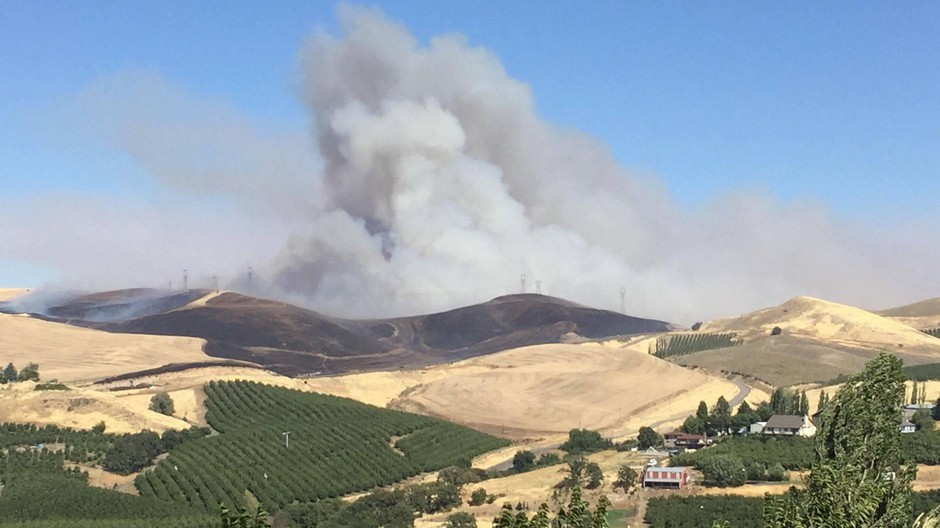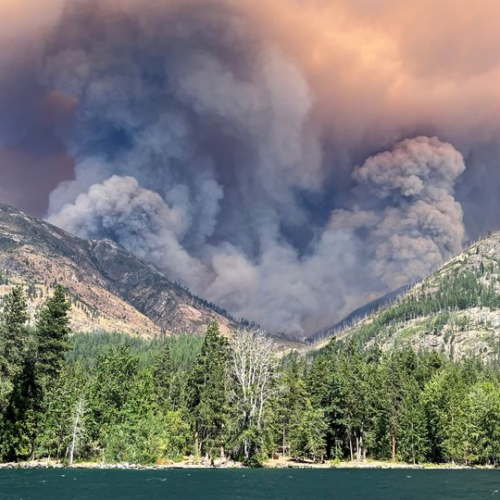
Q&A: How Investigators Sniff Out Wildfire Causes
Listen
The Substation Fire east of The Dalles has killed one person and burned more than 70,000 acres on a mix of Bureau of Land Management and private land. The fire is estimated to be 92 percent contained as of Monday morning.
The cause of the fire remains under investigation. Here’s what we know about it and how wildland fire investigations occur.
What Is Known About The Substation Fire Investigation?
The fire started on private land on July 17 and spread quickly. It has been called “incendiary in nature” and multiple state officials, including Gov. Kate Brown, have reportedly referred to the case as suspected arson.
The Wasco County Sheriff’s Office referred to it as a criminal investigation. The Sheriff’s office is leading that investigation with the help of four state and federal agencies: Oregon State Police, the Oregon State Fire Marshal, the U.S. Bureau of Land Management and the U.S. Forest Service.
Chief Deputy Scott Williams told OPB the Wasco sheriff still has a large investigative team working the fire and will release details as it can.
The sheriff’s office did not respond to questions about a timetable for the investigation, what evidence led to the determination the fire was “incendiary” in nature or whether investigators had identified any persons of interest.
How Do Investigators Determine The Cause Of A Wildland Fire?
Like many investigations, wildland fire investigators begin by talking to witnesses and gathering information from first responders on the likely location and cause of the fire. Then, they attempt to verify or disprove that information with physical evidence.
This means establishing the perimeter of the fire and tracing the path and direction of the burn back to a point of origin.
This differs from investigating building fires and requires a certification as a wildland fire investigator. The National Wildfire Coordinating Group offers a 337-page handbook on how to conduct such investigations. Often the area involved could be much larger, and the environment is constantly changing. Whereas a building fire likely has burn patterns on its walls or ceiling that remain undisturbed, wildfire investigations do not.
Using physical evidence such as the patterns of burns scars on trees, the direction of grass stems on the ground or which side of a rock is covered in char and soot, investigators will trace their way back to as small an area as possible where the fire could have started. Sometimes they can narrow it down to one object. Often, it’s an area of about 10 feet by 10 feet.
What Are They Looking For?
Assuming they have ruled out lightning, they search the nearby area for signs of accidental causes, like power lines.
Investigators then split that 10 by 10 patch into a grid, often using twine, like in an archeological dig. They look 1 square foot at a time, often examining it with magnifying glasses or metal detectors.
They are looking for anything that seems like it doesn’t belong, according to Paul Steensland, a fire investigation consultant who spent decades as an investigator for the Forest Service.
“We try not to have any preconceived notions, we don’t want to engage in any kind of confirmation bias,” Steensland said. “You’re usually looking for something that’s quite small, quite black and is in the middle of a whole bunch of other black stuff.”
Examples of what they find are scraps of metal that might have sparked a fire, or matches and cigarettes or other signs of incendiary devices.
Once they do determine the cause, if it is an incendiary device, then the investigation starts to look similar to any type of fire or criminal investigation: interviewing and gathering evidence to determine who had the ability to set the fire, then ruling out suspects.
The Fire Has Been Called “Incendiary In Nature” … What Does That Mean?
Incendiary is a technical term that means “A fire that is deliberately ignited under circumstances in which the person knows that the fire should not be ignited.”
As defined by the National Wildfire Coordinating Group, an incendiary fire doesn’t necessarily meet the definition of arson. For instance, someone burning trash without a permit at the wrong time of year could potentially fit the definition.
Multiple fire investigators said that is not typically how the term is used.
“Incendiary suggests somebody set the fire with the intention of watching it burn or causing economic damage. There’s an intention there,” said Kevin Lewis, vice president of fire forensics at the firm Jensen Hughes. Lewis, a metallurgical and materials engineer, frequently consults for law enforcement and private parties on wildland fire investigations.
“If they’ve categorized the fire as incendiary it means they’ve got a suspect or suspects and motivation and generally some evidence at the scene that somebody did something intentionally to start the fire as opposed to being careless,” Lewis said.
Does A Fatality From The Fire Affect The Investigation?
“It completely does. It’s now become a homicide potentially,” Steensland said. “Particularly if it was set deliberately.”
Under Oregon law, an arson that causes a fatality could result in a felony murder charge.
This, of course, depends on what the investigation finds.
It has happened elsewhere. In 2009, Raymond Lee Oyler was sentenced to death for starting the Esparanza Fire west of Palm Springs, California, after it resulted in the deaths of five firefighters.
Right now, the Substation Fire has been called a criminal investigation and reportedly referred to as “suspected arson.”
Ultimately, if arson is ruled out, such a charge would not be the case.
Copyright 2018 Oregon Public Broadcasting
Related Stories:

Intense fire week forces road closures and evacuation notices in WA
Fire crews continue firing wildfires to keep on high alert in the Northwest.

Gwen Fire forced evacuation in Juliaetta, Idaho
Multiple fires in Latah and Nez Perce counties in Idaho forced the evacuation of Juliaetta, Myrtle, Cherryland, and Arrow areas Thursday night.

Washington deals with peak fire season conditions, state agencies ready to respond
Everyone watching fires around Washington this week held their breath as about 600 lightning strikes hit the landscape across the state.
The Washington State Department of Natural Resources, who, alongside agency partners, prepared for those conditions this week by pulling in out-of-state resources and pre-positioning crews. The lightning strikes ignited at least two fires in the state, the Easy fire and Swawilla fire. According to a public information officer on the Swawilla fire, a series of fires started from lightning strikes on the Colville Reservation this week.













